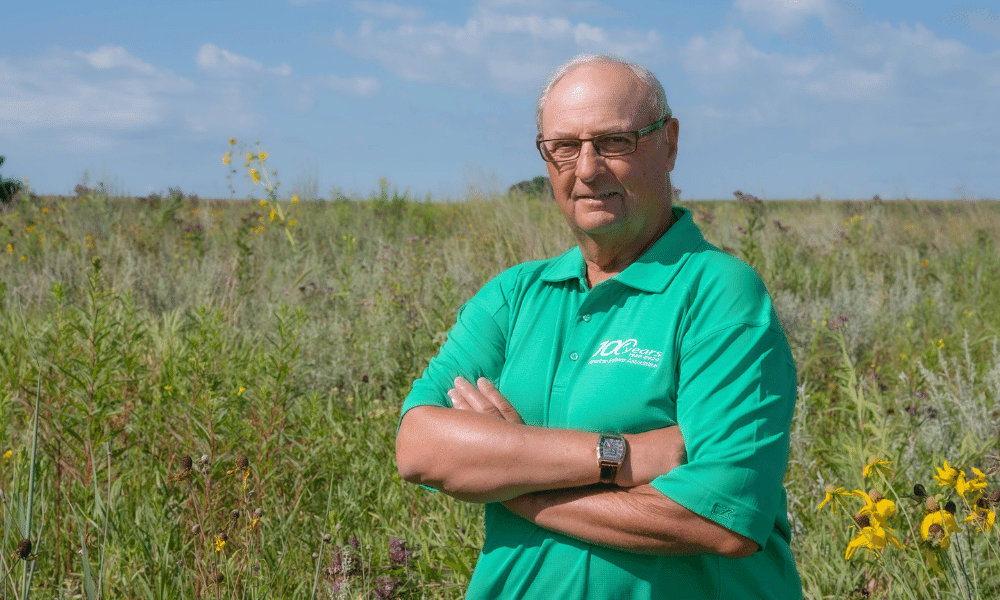
Implementing conservation practices has been a boon to Wayne Fredericks’ budget and crop yields. (Photo: Iowa Soybean Association)
Saving Time & Money: Change in weather shifts farmer's conservation trajectory
May 5, 2021 | Bethany Baratta
Wayne Fredericks and his wife Ruth began farming in northern Iowa in the early 1970s. For the first 19 years, their farm was managed conventionally. Corn stalks were plowed and soybean stubble was tilled before planting.
It was a change in the weather that altered their conventional farming practices for the better.
“In the winter of 1991, we had an early freeze, and I didn’t get any of our fall plowing done,” Wayne recalls. “I sat in my office in December wondering what the heck I was going to do.”
Wayne stumbled upon an article in a farm magazine about a farmer no-tilling soybeans. He was intrigued. Later, a discussion with his John Deere implement dealer turned into a proposition. The dealer was going to get a no-till drill to run a trial, and he would lend it to Wayne if he was interested.
The result: good growth and weed control plus outstanding yields.
“I was hooked,” Wayne says. “I went from plowing to no-till soybeans in one fell swoop.”
Though Wayne was initially wary of no-till corn, he has found a way to optimize the economics of his corn fields using a strip-till system. He applies phosphorous and potassium in the fall in those strips with the goal of maximizing nutrient efficiency and reducing nutrient loss. In the spring, he no-tills into those fall-built strips. He’s found the strips more suitable for planting; 7 to 10 degrees warmer and drier. It works well in his system, especially since he’s operating without additional labor.
Addressing weather and water quality
His motivation for implementing cover crops was improving water quality, not economics. Over time, however, he found combining cover crops with no-till generated substantial financial value.
Wayne first got involved with cover crops through replicated strip trials run by the Iowa Soybean Association (ISA) Research Center for Farming Innovation. The trials revealed what species worked well on his farm and how cover crops affected crop yields. Partaking in the trials heightened Wayne’s awareness of cover crops and the benefits they have for water quality, including meeting Iowa’s nutrient reduction goals.
On-farm water quality monitoring through ISA measured nitrogen levels at 13.23 mg/liter in the water draining off his soybean fields – higher than the drinking water standards at 10 mg/L. When the field was in corn, the samples revealed a nitrogen rate of 13.98 mg/L.
After implementing cover crops into his system in 2016, Wayne saw a vast improvement in nitrate levels.
“I planted into the tall green cereal rye, and our tiles tested at 4.17 mg/Liter, a 70% reduction in nitrogen,” Wayne says. “I was starting to get excited when I saw the results.”
A close look at economics
Reduced tillage practices and implementation of cover crops has improved soil structure and increased organic matter in Wayne’s fields while reducing soil loss and fertilizer input costs.
Various studies show advantages in several areas of his operation, including equipment, labor and fertilizer costs, improved weed control, and reduced soil loss (see chart).
Wayne’s transition to conservation practices has also provided financial benefits through increased soil organic matter content.
Studies in cooperation with the National Laboratory for Agriculture and the Environment have shown a 2.5% increase in soil organic matter from 1990 to 2015. Estimates through NRCS show that a 1% increase in organic matter generates, on average, $18 per acre in moisture retention and $11 per acre in mineralized nitrogen and phosphorous (represented in the table as fertilizer cost savings). Considering savings through crop insurance and subtracting $27 per acre in cover crop costs leaves a net savings of $138 per acre through conservation.
Data Drives Decisions
Research and trial data help drive decisions on Wayne’s farm. He’s also a believer in collaboration, cooperation and conservation. He’s worked with various groups to demonstrate how additional practices on the farm can help move the needle on water quality in Iowa. He’s designed and planted a windbreak, waterways, bioreactors and strategically placed pollinator habitats on his farm.
He knows, however, that federal and state policies also influence farm-level decisions, just as the 1985 Farm Bill placed an emphasis on conservation and reduced tillage methods (from moldboard plowing to chisel plows). Evaluating these decisions on a farm-by-farm basis can aid other farmers in their decision making too, he says.
“Maybe it’s hard in the beginning to point out the profitability associated with cover crops,” he says. “But I think in the long term – like no-till is in relation to moldboard plowing – it’s the right thing to do.”
This story was originally published in the Spring 2021 issue of the Iowa Soybean Review.
Back